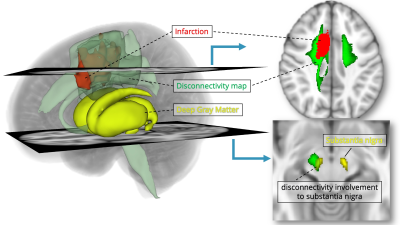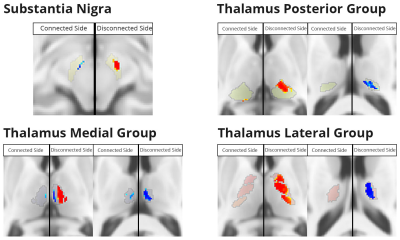Takayuki YAMAMOTO1, Hikaru FUKUTOMI1, Vincent DOUSSET1,2, Igor SIBON3, and Thomas TOURDIAS1,2
1Institut de Bio-imagerie IBIO, Université de Bordeaux, Bordeaux, France, 2Neuroimagerie diagnostique et thérapeutique, CHU de Bordeaux, Bordeaux, France, 3Unité de soins intensifs neurovasculaires, CHU de Bordeaux, Bordeaux, France
1Institut de Bio-imagerie IBIO, Université de Bordeaux, Bordeaux, France, 2Neuroimagerie diagnostique et thérapeutique, CHU de Bordeaux, Bordeaux, France, 3Unité de soins intensifs neurovasculaires, CHU de Bordeaux, Bordeaux, France
We investigated the relation between stroke and remote consequences
using probability maps of damaged tractograms. We demonstrated that such
disconnectivity approach can successfully predict regions that will degenerate
and show long term iron accumulation.

Figure 1. Overview of a representative disconnectivity map. Disconnectivity map (green) is calculated using the lesion mask of the infarction (red), based on the tractograms of healthy subjects. The degree of overlap of the disconnectivity map and masks of deep nuclei was used to estimate the remote effect of the infarction.

